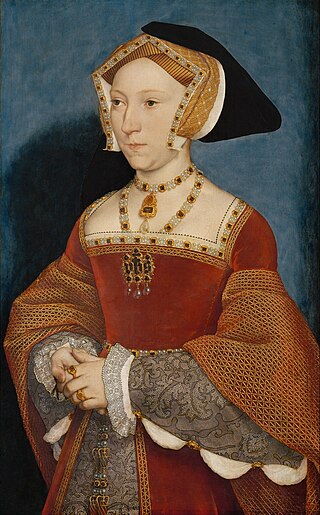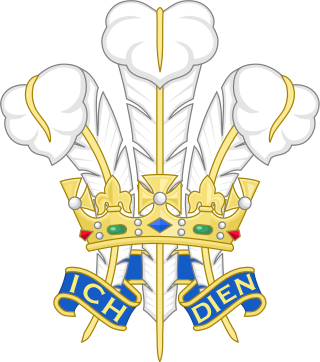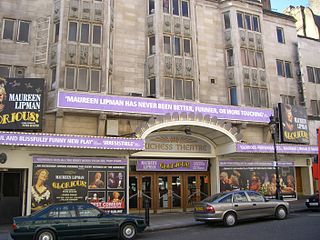
Catherine of Aragon was Queen of England as the first wife of King Henry VIII from their marriage on 11 June 1509 until its annulment on 23 May 1533. She was Princess of Wales while married to Henry's elder brother, Arthur, Prince of Wales, for a short period before his death.

The House of Tudor was an English and Welsh dynasty that held the throne of England from 1485 to 1603. They descended from the Tudors of Penmynydd, a Welsh noble family, and Catherine of Valois. The Tudor monarchs ruled the Kingdom of England and the Lordship of Ireland for 118 years with five monarchs: Henry VII, Henry VIII, Edward VI, Mary I and Elizabeth I. The Tudors succeeded the House of Plantagenet as rulers of the Kingdom of England, and were succeeded by the Scottish House of Stuart. The first Tudor monarch, Henry VII, descended through his mother from the House of Beaufort, a legitimised branch of the English royal House of Lancaster, a cadet house of the Plantagenets. The Tudor family rose to power and started the Tudor period in the wake of the Wars of the Roses (1455–1487), which left the main House of Lancaster extinct in the male line.

Jane Seymour was Queen of England as the third wife of King Henry VIII from their marriage on 30 May 1536 until her death the next year. She became queen following the execution of Henry's second wife, Anne Boleyn, who was accused by Henry of adultery after failing to produce a male heir. Jane, however, died of postnatal complications less than two weeks after the birth of her only child, the future King Edward VI. She was the only wife of Henry to receive a queen's funeral; and he was later buried alongside her remains in St George's Chapel, Windsor Castle.

Mary Tudor was an English princess who was briefly Queen of France as the third wife of King Louis XII. Louis was more than 30 years her senior. Mary was the fifth child of Henry VII of England and Elizabeth of York, and the youngest to survive infancy.
The Six Wives of Henry VIII is a series of six television plays produced by the BBC and first transmitted between 1 January and 5 February 1970. The series later aired in the United States on CBS from 1 August to 5 September 1971 with narration added by Anthony Quayle. The series was rebroadcast in the United States without commercials on PBS as part of its Masterpiece Theatre series.

The history of the English penny from 1485 to 1603 covers the period of the House of Tudor up to the death of Elizabeth I without an heir. The Tudor era saw the debasement of the penny under Henry VIII and Edward VI, with Elizabeth I's reign overseeing the recovery of the silver quality. Under the Tudors, the penny decreased in size.

Charles Brandon, 1st Duke of Suffolk was an English military leader and courtier. Through his third wife, Mary Tudor, he was brother-in-law to King Henry VIII.

Una O'Connor was an Irish-born American actress who worked extensively in theatre before becoming a character actress in film and in television. She often portrayed comical wives, housekeepers and servants. In 2020, she was listed at number 19 on The Irish Times list of Ireland's greatest film actors.

A heraldic badge, emblem, impresa, device, or personal device worn as a badge indicates allegiance to, or the property of, an individual, family or corporate body. Medieval forms are usually called a livery badge, and also a cognizance. They are para-heraldic, not necessarily using elements from the coat of arms of the person or family they represent, though many do, often taking the crest or supporters. Their use is more flexible than that of arms proper.

The Duchess Theatre is a West End theatre in the City of Westminster, London, located in Catherine Street near Aldwych.

Rosalie Sylvia Crutchley was a British actress. Trained at the Royal Academy of Music, Crutchley was perhaps best known for her television performances, but had a long and successful career in theatre and films, making her stage debut as early as 1932, and her screen debut in 1947.
Barbara Leigh-Hunt was an English actress. Her numerous theatre credits included Broadway productions of Hamlet (1958), Sherlock Holmes (1973) and Justice (1974), and she won the 1993 Olivier Award for Best Supporting Actress for the National Theatre production of An Inspector Calls. Her film appearances included Frenzy (1972), Henry VIII and His Six Wives (1972), Bequest to the Nation (1973), and Billy Elliot (2000).

Henry VIII is an opera in four acts by Camille Saint-Saëns, from a libretto by Léonce Détroyat and Armand Silvestre, based on El cisma en Inglaterra (1627) by Pedro Calderón de la Barca.
A Crown of the Rose is an extremely rare gold coin of the Kingdom of England introduced in 1526 during the reign of Henry VIII, in an attempt to compete with the French écu au soleil. The coin was not a success and just a few months later it was replaced by the Crown of the Double-Rose.

Henry VIII and his reign have frequently been depicted in art, film, literature, music, opera, plays, and television.

Catherine Howard was Queen of England from July 1540 until November 1541 as the fifth wife of King Henry VIII. She was the daughter of Lord Edmund Howard and Joyce Culpeper, a cousin to Anne Boleyn, and the niece of Thomas Howard, 3rd Duke of Norfolk. Thomas Howard was a prominent politician at Henry's court. He secured her a place in the household of Henry's fourth wife, Anne of Cleves, where Howard caught the King's interest. She married him on 28 July 1540 at Oatlands Palace in Surrey, just 19 days after the annulment of his marriage to Anne. He was 49, and it is widely accepted that she was about 17 at the time of her marriage to Henry VIII.
Mary Hall was an English gentlewoman whose report of the 'light' behaviour in her youth of Henry VIII's fifth Queen, Catherine Howard, initiated the process which ended with Queen Catherine's execution.
A Rose without a Thorn is a 1958 Australian television play about King Henry VIII's marriage to Catherine Howard. It was directed by Alan Burke from a play by Clifford Bax. The play was shown live in Sydney, recorded, then shown in Melbourne.

The Queen Who Kept Her Head is a 1934 historical play by the British writer Winifred Carter. It is based on the life of Catherine Parr, the sixth and final wife of Henry VIII, who outlived him.

Catherine of Aragon was Queen of England from June 1509 until May 1533 as the first wife of King Henry VIII. She has been portrayed in film, television, plays, novels, songs, poems, and other creative forms many times, and as a result, she has stayed very much in popular memory.















